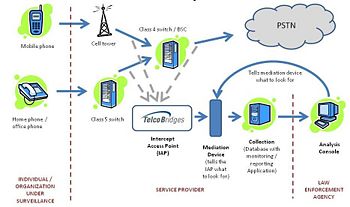Lawful intercept
(added picture and content) |
(→TelcoBridges and Lawful intercept) |
||
| Line 15: | Line 15: | ||
| − | + | '''One important note:''' The very same Tmonitor hardware in place at a service provider used to respond to [[Lawful intercept|lawful intercept]] mandates to can be used to perform [[Network monitoring|network monitoring]] activities and provide [[Location-based services|location-based services]]. This allows service providers to maximize their investment by achieving additional business objectives and, in the case of location-based-services, actually monetizing the data generated by network activity. | |
| − | + | ||
== References == | == References == | ||
Revision as of 14:08, 17 July 2009
Service providers perform lawful intercept activities such as wiretapping to meet government mandated legal requirements. While exact delays vary according to the jurisdiction, there is usually an obligation to commence lawful intercept activities within a set timeframe.
The challenge for service providers has been to cost-effectively meet lawful intercept requirements. Historically, this has meant deploying monitoring software on a subset of network components or purchasing a limited number of hardware probes that are then shuttled around the network. The immediate problem is that while network equipment can be configured to perform network monitoring, with the purchase of additional software from the equipment manufacturer, this comes at the cost of overall network performance since it requires resources normally dedicated to call connection and control. The use of hardware probes often introduces latency and in many cases requires communications to be temporarily interrupted to install the equipment. Any disruption to the service that could tip off the person(s) under surveillance defeats the purpose of the lawful intercept effort.
Both solutions, hardware and software, have often been single purpose in nature, merely increasing the costs of operations with no additional upside for the provider.
TelcoBridges and Lawful intercept
The TelcoBridges Tmonitor family of products (TM1000 and TM2000 for T1/E1/J1 networks; the TM3000 for STM-1 networks) provide a high-performance network monitoring solution that can be cost-effectively deployed to support lawful intercept activities.
Tmonitor devices perform non-intrusive, full-duplex monitoring, filtering, and analysis of traffic such as SS7 and ISDN signaling, HDLC frames, as well as raw traffic on T1/E1/JI or STM-1 interfaces at line speed, providing up to 100% packet capture. It features highly configurable on-board packet filters so that only relevant information is captured from traffic streams and stored. Tmonitor also allows service providers to also record up to 256 channels of voice traffic in the TM1000 and much higher in subsequent models.
Unlike software-based solutions running on the base station controller, Tmonitor devices impose no additional overhead on the core network equipment. Unlike a hardware probe, Tmonitor creates no additional latency and therefore no performance hit.
One important note: The very same Tmonitor hardware in place at a service provider used to respond to lawful intercept mandates to can be used to perform network monitoring activities and provide location-based services. This allows service providers to maximize their investment by achieving additional business objectives and, in the case of location-based-services, actually monetizing the data generated by network activity.
